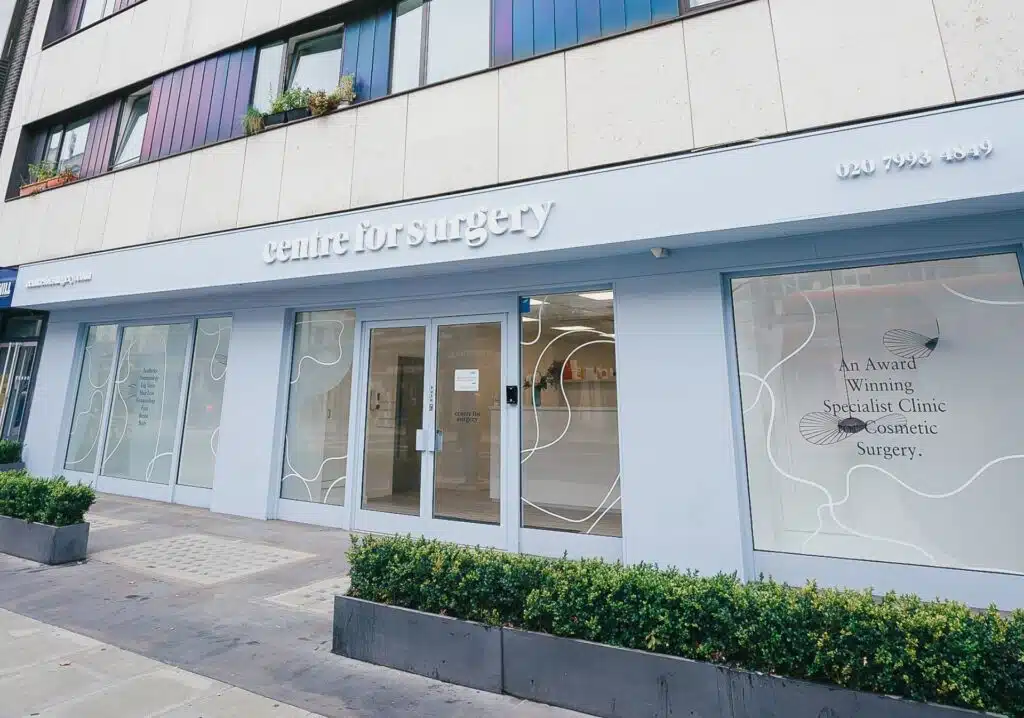How Reducing Breast Size Can Improve Your Breathing
Have you ever felt like it’s hard to catch your breath? If you’ve got large breasts, this could be more than just an annoyance. Beyond making it tricky to find clothes that fit well and feeling self-conscious, having large breasts can actually affect your health. It’s not just about backaches and not being able to stand up straight – it can make breathing properly a real challenge.
Here at Centre for Surgery, we understand that choosing to have cosmetic surgery goes beyond wanting to look a certain way. Procedures like breast reduction surgery are not only about improving how you look but are also focused on making you feel better physically. Reducing the size of your breasts can help ease the effort it takes to breathe, while also giving your confidence a boost.
In our latest discussion, we dive into how the weight of your breasts can impact your breathing and overall respiratory health. We’re also shedding light on how surgery can offer a way to not only breathe with ease but also walk with more confidence in your step.
How Big Breasts Can Lead to Breathing Difficulties: Making the Link
Did you know that having big breasts could make it tougher to breathe? It’s not just a case of feeling uncomfortable or finding it hard to shop for clothes that fit well. The real issue lies in the additional weight pressing down on your chest. This weight comes from the glandular and fatty tissues in your breasts, which can put a strain on your muscles and ribs, limiting how effectively your diaphragm can move. Essentially, your body has to put in extra effort for each breath you take.
However, it’s important to note that not every woman with large breasts will experience breathing difficulties. The problem tends to be more common among those with a higher body mass index (BMI), which calculates body fat based on your height and weight.
So, what specific breathing issues can arise from having large breasts? Let’s delve deeper into how this added weight can complicate your ability to breathe comfortably.
Breathing Challenges From Having Larger Breasts
Breathing difficulties can significantly impact your daily life, and for women with larger breasts, these issues can be particularly pronounced. While not the only discomfort associated with larger breast sizes, respiratory problems stand out due to their direct effect on overall well-being.
Many women find their breathing compromised in everyday situations, struggling to take full, deep breaths. This difficulty can become even more apparent during physical activity, when lying on their back, or engaging in tasks that require more exertion.
Let’s examine the most frequent breathing complications associated with large breasts:
- Shortness of Breath: The added weight on your chest can press down on your lungs, making it challenging to achieve deep and complete inhalations.
- Altered Posture and Reduced Lung Capacity: The burden of heavy breasts can lead to poor posture, with a tendency to lean forward. This posture can restrict how much your lungs can expand, diminishing breathing efficiency.
- Decreased Physical Stamina: A lower lung capacity means your body has to work harder to circulate oxygen, leading to faster exhaustion and diminished endurance during physical activities.
- Worsened Asthma Symptoms: For individuals with asthma, the extra chest pressure can intensify breathing difficulties, making asthma management more complex.
- Sleep Apnoea: This sleeping disorder, marked by interruptions in breathing, can be exacerbated by larger breasts, which complicate breathing at night.
- Increased Anxiety and Stress: Struggles with breathing can trigger anxiety, creating a feedback loop that exacerbates both stress and respiratory issues.
If you’re finding breathing to be a constant struggle, it might be time to consider seeking help. The silver lining is that there are both surgical and non-surgical avenues available to alleviate these breathing issues, enabling you to feel better and more confident in your body.
One of the most impactful interventions is breast reduction surgery, which can dramatically transform your quality of life by addressing the root cause of these respiratory challenges.
RELATED: The Transformative Effects of Breast Reduction Surgery
Breast Reduction Surgery
Breast reduction surgery, also known as reduction mammaplasty, offers a transformative solution for those seeking relief from the physical and respiratory discomfort caused by overly large breasts. This procedure isn’t just about altering your appearance; it’s a step towards a more comfortable and healthy life, especially for those struggling with breathing issues.
RELATED: What Are The Medical Reasons To Get A Breast Reduction?
The process involves the surgeon making a precise, anchor-shaped (or inverted T) incision that circles the areola and extends down to the breast crease. Through this incision, a cannula—a slender tube—is introduced to perform liposuction, effectively removing fat and excess tissue from the breasts. The surgeon then skillfully reshapes and contours the remaining breast tissue, ensuring the new size and shape are not only more proportionate to your body’s frame but also facilitate better posture and reduced physical discomfort.
RELATED: Anchor vs Lollipop Breast Reduction
Following the resizing and reshaping, the surgeon lifts the breasts to a position that appears more natural and aesthetically pleasing, enhancing their overall look and projection. This meticulous procedure is carried out under both general and local anaesthesia and typically lasts between three to four hours.
RELATED: Will I Lose Feeling in My Nipples After Breast Reduction Surgery?
Recovery from breast reduction surgery is a gradual process, with full recovery expected within four to six months, assuming no additional surgeries are undertaken. This period allows your body to adjust to its new shape and for you to experience the full benefits of the surgery, including improved respiratory function, less physical strain, and a boost in self-confidence.
Who is the Right Candidate for Breast Reduction Surgery?
Determining if breast reduction surgery is the right path for you involves more than just a desire to reduce your breast size; it’s about improving your quality of life. Your surgeon will thoroughly evaluate when you come in for a consultation. This includes reviewing your health status, anatomical structure, medical history, and what you hope to achieve through surgery. This comprehensive assessment ensures that breast reduction is a suitable and safe option for addressing your concerns, especially if they include respiratory difficulties.
Here are the key criteria that may make you a good candidate for breast reduction surgery:
- Respiratory Distress Caused by Large Breasts: If you find it challenging to breathe, particularly due to the size of your breasts, a breast reduction could offer significant relief.
- Difficulty Engaging in Physical Activity: Large breasts can hinder your ability to participate in physical activities. If this is a concern for you, reduction surgery might be the solution.
- Overall Good Health: Ideal candidates are those without serious medical conditions that could complicate surgery or recovery.
- No Contraindications with Anaesthesia: You should not be taking any medications that adversely interact with anaesthesia or the medications prescribed after breast surgery.
- Willingness to Follow Surgical Guidance: Committing to your surgeon’s pre- and post-operative instructions is crucial for a successful outcome.
- Ability to Stop Smoking: If you smoke, you’ll need to quit for a specified period before and after the surgery to enhance healing and reduce the risk of complications.
- Not Pregnant or Breastfeeding: You should not be pregnant, breastfeeding, or planning to become pregnant soon, as these conditions can affect the surgery’s outcomes and recovery.
- Realistic Expectations: Having a clear understanding of what the surgery can and cannot achieve, including its limitations and potential risks, is important.
Benefits of Breast Reduction Surgery
Opting for breast reduction surgery can lead to a significant enhancement in both physical and psychological well-being, extending far beyond the primary goal of easing breathing difficulties. Here’s a look at the multifaceted benefits this transformative procedure offers:
- Relief from Neck, Back, and Shoulder Pain: The reduction of breast weight can dramatically alleviate chronic pain in the neck, back, and shoulders, offering a more comfortable daily life.
- Reduction of Skin Irritation: Smaller breasts can reduce the risk of skin irritation and infections that occur under the breast fold.
- Elimination of Bra Strap Indentations: By reducing breast size, the pressure on the shoulders from bra straps is lessened, eliminating painful indentations.
- More Clothing Options: A smaller breast size opens up a wider range of clothing and bra options, making shopping less frustrating.
- Fewer Headaches: The reduction in neck and shoulder tension can also lead to a decrease in headaches.
- Increased Physical Comfort: A more manageable breast size can make physical activities and exercise more enjoyable and less cumbersome.
- Improved Posture: Lighter breasts contribute to better posture by reducing the forward pull on the spine.
- Enhanced Sleep Quality: With less chest pressure, you may find sleeping more comfortable, particularly in certain previously challenging positions.
- Lower Risk of Breast Sagging: By reducing their size, the breasts are less likely to sag and maintain a more youthful appearance for longer.
- Boosted Confidence: Many individuals report a significant boost in self-confidence and body image after surgery.
- More Accurate Breast Health Screenings: Smaller breasts can sometimes make mammograms and other breast health screenings more effective by allowing for better imaging.
- Improved Quality of Life: Collectively, these benefits substantially improve overall quality of life.
Risks of Breast Reduction Surgery
Breast reduction surgery offers a pathway to improved quality of life, alleviating physical discomfort and enhancing self-confidence. However, as with any surgical procedure, it’s important to be aware of the potential risks and considerations involved. Being fully informed helps ensure you make a decision that’s right for you.
RELATED: Breast Reduction Complications – Reducing Risks of Surgery
Here are some of the complications that may arise from breast reduction surgery, especially if post-operative care instructions aren’t followed or if the procedure encounters issues:
- Anesthesia Complications: Reactions to anaesthesia, while rare, can pose serious risks.
- Allergic Reactions: Allergic responses to materials used during surgery can occur.
- Visible Scarring: While surgical techniques aim to minimise scarring, some visible marks are inevitable.
- Altered Nipple Sensation: Changes in nipple sensitivity, either increased or decreased, can occur post-surgery.
- Risk of Infection: As with any surgery, there’s a risk of infection at the incision sites.
- Blood Clots or Bleeding: There’s a small risk of developing blood clots or experiencing bleeding after surgery.
- Poor or Delayed Healing: Healing rates vary by individual, and some may experience slow or complicated healing processes.
- Asymmetrical Results: There’s a possibility that breasts may not be perfectly symmetrical after surgery.
- Breastfeeding Difficulties: The ability to breastfeed might be affected, as milk ducts and nerves may be disrupted during surgery.
- Need for Breast Revision Surgery: In some cases, additional surgery may be needed to correct or refine the initial results.
To minimise these risks, it’s crucial to select a highly experienced surgeon specialising in breast reduction, such as those at Centre for Surgery. Following your surgeon’s pre- and post-operative advice closely can significantly reduce the likelihood of complications and ensure a smoother recovery.
Exploring Non-Surgical Relief for Breathing Discomfort Due to Large Breasts
While the transformative outcomes of breast reduction surgery are appealing to many, it’s understandable if you’re looking for less invasive ways to alleviate the discomfort associated with large breasts. Non-surgical options might not provide permanent solutions but can offer notable relief and improve your quality of life.
Here are some effective non-surgical strategies to consider:
- Weight Management: Keeping your body weight within a healthy range can lessen the overall load on your chest and contribute positively to your respiratory health. This approach benefits your entire body, improving your energy levels, mobility, and breathing capacity.
- Posture Exercises: While these exercises won’t change your breast size, they can make a world of difference to how you feel. Correcting your posture through targeted exercises can realign your body, relieving the pressure on your lungs and making it easier to breathe. Improved posture also enhances your appearance and boosts your confidence.
- Supportive Clothing: Never underestimate the power of a well-fitted bra. Supportive bras designed for larger breasts can distribute their weight more evenly across your chest, significantly reducing the burden and improving posture and breathing. Investing in the right bras is a simple yet effective way to feel better immediately.
- Physiotherapy for Large Breasts: Consulting with a physiotherapist can be incredibly beneficial. They can tailor exercises specifically for you, aimed at strengthening the muscles in your back, neck, and shoulders. This can help manage the physical strain large breasts place on your body and enhance your respiratory function by ensuring you’re not only stronger but also able to breathe more easily.
Embrace a Life of Comfort and Confidence with Centre for Surgery













